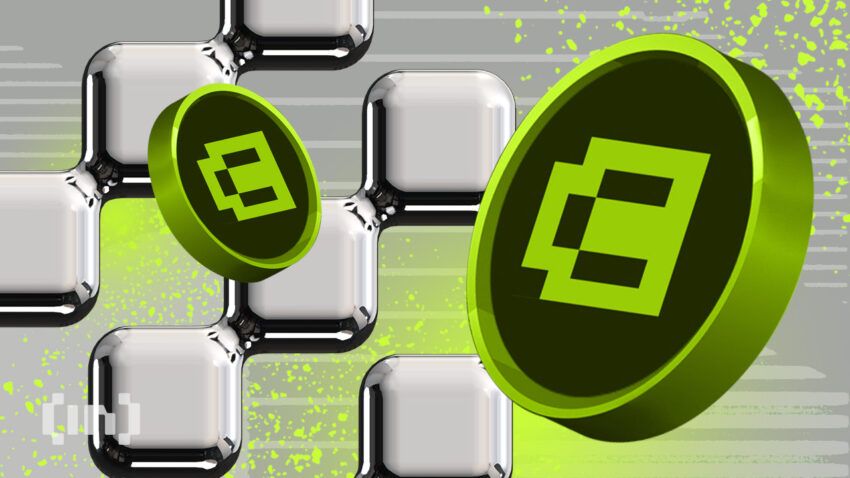Have you heard about the hype around Canto? A permissionless layer-1 blockchain, the Ethereum competitor’s impressive DEX trading volume is earning the altchain a fair share of attention. But what is Canto, and what sets it apart from the L1s already on the market?
The core tenets of the project suggest high aspirations to promote fairness and equity in cryptocurrency, a problem yet to be solved in web3 or traditional finance. But does Canto have what it takes to deliver on its promises? Let’s take a look.
BeInCrypto Trading Community in Telegram: read all the hottest news, discuss blockchains, get technical analysis on coins & answers to all your questions from PRO traders & experts!
What is Canto?

Essentially, Canto is a generalizable layer-1 (L1) blockchain. This means that developers are able to create smart contracts and decentralized applications on their virtual machines. Like Ethereum, it is also proof-of-stake (PoS) and so can boast some form of green credentials.
Additionally, Canto provides public infrastructure that’s free to use. It was created to fulfill decentralized finance’s (DeFi’s) promise: making new systems accessible, transparent, decentralized, and free through a new financial movement.
Origin
Cantos uses the Cosmos SDK (software development kit). It runs on the Tendermint consensus engine and uses Ethermint to deploy the EVM. This is what makes it EVM-compatible. As a result, Canto has a native bridge between CosmWasm tokens and ERC-20 standard tokens.
Team
The L1 altchain is the brainchild of a loosely organized collective of programmers; because of this, not much is known about many of the developers. However, one notable presence is that of Scott Lewis. The co-founder of DeFi Pulse, Slingshot, Hyype, Atrium, and Code4rena also contributes to Canto.
The Plex team is a key contributor to the Canto infrastructure. The chain-native developers have experience in high-frequency trading, mechanism design, and software development with a keen interest in DeFi.
Funding
Canto states the project remains a free, permissionless, decentralized public infrastructure. In order to remain true to their ideals of decentralization, the project reportedly did not receive any initial venture capitalist funding. However, the Variant fund has reported an undisclosed position in Canto.
Roadmap
At present, Canto does not have a publicly available roadmap. Nevertheless, this does not mean there are no future plans. The core philosophy of the project revolves around free public goods or primitives. The idea is that primitives like a unit of account (e.g., a stablecoin), borrowing and lending markets, and decentralized exchanges (DEXs) should be native to a protocol.
As time goes on, developers will add more native primitives as needed. Therefore, the DAO will essentially have unified governance over all primitives built as free public infrastructure. This means Canto stakers can participate in governance over the native decentralized exchange, borrowing and lending application, and the protocol itself.
How does Canto work?
Because Canto is compatible with EVM (Ethereum Virtual Machine), developers can effortlessly migrate their smart contracts and decentralized applications to Canto. This also means that you can use wallets like Metamask to interact with the blockchain. Canto also uses Geth, the battle-hardened client.
Geth is an Ethereum execution client, which means it manages transactions, smart contract deployment, and execution. In layman’s terms, Canto behaves and feels like Ethereum. The only subtle differences are Canto’s gas model, Canto’s EVM block time is six seconds, and uses Tendermint consensus. Not to mention, it is built using the Cosmos SDK.
Canto features
As mentioned before, the core tenets of the project specify free public infrastructure. These are native technologies that come standard with the protocol. Primitives are built natively to prevent problems like rent extraction. At present, there are three primitives: a DEX (Canto DEX), a borrowing and lending market (CLM), and a unit of account ($NOTE).
Canto DEX
In order to prevent rent-seeking behavior (e.g., maximal extractable value — MEV), Canto DEX is built native to the blockchain. Rent-seeking occurs when an entity seeks to gain wealth or acquire funds without making any reciprocal contribution. Canto DEX prevents rent-seeking for the following reasons:
- It has no official interface
- It is not upgradeable
- It cannot implement fees
However, users can become liquidity providers on the DEX. Canto DEX has two types of liquidity pools: full-range liquidity pools and concentrated liquidity pools. At the moment, there are five incentivized liquidity pools.
- USDC/NOTE (Concentrated liquidity pool)
- USDT/NOTE (Concentrated liquidity pool)
- NOTE/CANTO (Full range liquidity)
- CANTO/ETH (Full range liquidity)
- CANTO/ATOM (Full range liquidity)
Canto Lending Market (CLM)
You can consider CLM the equivalent of Ethereum’s Aave or Compound protocols. CLM will accept LP tokens as collateral from Canto’s native decentralized exchange. Users can deposit this collateral as supply in CLM but can not borrow the LP tokens. As mentioned, stakers with the Canto DAO oversee the governance of CLM.
CLM is based on Compound V2, with a few differences. Firstly, there is no CLM lending token, unlike Compound’s COMP. Secondly, CLM’s governance is handled by Canto’s DAO, as opposed to Compound’s DAO, which exclusively governs the decentralized application alone.
$NOTE
For any robust financial market, you need a unit of account. A unit of account is a standardized numerical monetary unit used to calculate the market value of goods, services, and other transactions — a.k.a. a measure. You use a dollar to price goods and services the same way you use $NOTE.
$NOTE is the native unit of account. It is an over-collateralized token with an interest rate policy centered around $1 USD. $NOTE is not created. You must borrow it from the Accountant, a smart contract that implements the algorithmic interest rate policy, through the Canto Lending Market. A portion of the interest rate goes to the community treasury to fund public goods.
Canto’s strengths and opportunities
Canto has a lot of aspirations. Although we often wax poetic in web3 about how aspects of crypto are fairer than traditional finance, ultimately, the rich still get richer. As a result, power always consolidates based on wealth. Canto is attempting to remedy this very issue.
Free public infrastructure is a good attempt to solve this problem. However, at the moment, rent-seeking (e.g., MEV) is an inescapable aspect of blockchains, and primitives alone cannot solve it. If that were currently possible, there would be little need to use rollups as an alternative to Ethereum.
To continue, proof-of-stake is an excellent choice of Sybil resistance if you want to build blockchains with faster transaction finality and more advanced features like child chains. Conversely, PoS removes the barrier that proof-of-work has to prevent Sybil attacks. This makes it easier to create a 51% attack. As a matter of fact, 51% of Canto’s stake is held by six addresses alone.
Lastly, although the project developers do not classify $NOTE as a stablecoin, it does have similarities with one, such as risk. $NOTE is both algorithmic and over-collateralized. Currently, the only collateral assets are USDC and USDT. If the price of USDC and USDT de-pegs, it creates a contagion risk.
Pros
- Native DEX, lending market, a unit of account, and bridge
- EVM compatible
- Proof-of-stake
- Testnet
Cons
- Six addresses hold 51% of the total stake
- Contagion risk of $NOTE
- Lack of clients
CANTO token
We’ve already discussed the uses of $NOTE. Although it is native to the protocol, it is not the native token to the blockchain. Canto has two native cryptocurrencies, the $NOTE token and the $CANTO token. NOTE is, and ERC-20 token is minted through smart contracts, while CANTO is minted through the token base (a.k.a., the block reward).
The initial total supply of $CANTO is one billion at genesis. There are 150 million tokens in the initial circulating supply. This is contrary to $NOTE, which has no max supply.
CANTO uses
The uses of $CANTO are pretty similar to other blockchains’ native cryptocurrency use cases. You can use it to pay for gas fees on the blockchain. Additionally, you can also stake $CANTO with validators. This will allow you to participate in governance, and earn additional tokens, all while securing the network.
Distribution
The initial circulating supply of $CANTO tokens is distributed as follows:
- 130,000,000 CANTO (13%) for initial contributors
- 20,000,000 CANTO (2%) for those who took part in the launch of the testnet
The remaining total supply of $CANTO is contingent upon the DAO proposals and distributed as follows:
- 450,000,000 CANTO (45%) for long-term liquidity mining, distributed over the next 5-10 years
- 350,000,000 CANTO (35%) for medium-term liquidity mining, distributed over the upcoming months and years
- 50,000,000 CANTO (5%) for future public goods grants
CANTO wallet
There are many resources native to the Canto ecosystem; however, there is no official CANTO wallet. Despite this fact, it is EVM-compatible, so many wallets work seamlessly with the blockchain. In the same way, you can adapt your MetaMask wallet to Arbitrum or Optimism, you can use your wallet with Canto.
For hardware wallets, both Ledger and Trezor‘s offerings are solid and secure choices.
Where to buy CANTO?
Despite the fact that it is relatively new, there are many places to buy CANTO. If you are looking for a DEX, then you can use Slingshot, a DEX aggregator platform. There are also a number of centralized exchanges where you can buy CANTO. These include MEXC, Gate.io, and BKEX.
Can Canto last?
On the surface, Canto is your run-of-the-mill L1 altchain. The project benefits from its predecessors and is the culmination of years of innovation-propelling composability. Thanks to Ethereum and Cosmos, deploying blockchains like Cantos with interchangeable parts to suit user needs is much easier.
The altchain is experimental in how it approaches DeFi services. This is apparent when analyzing the zero fee schedule for liquidity providers of Canto DEX. In contrast, the $NOTE token does present a relative risk, as it is the linchpin to the free public infrastructure. And Canto falls short on the side of innovation. It’s clear that the project can pump. But its longevity is yet to be put to the test.
Frequently asked questions
What is CANTO in crypto?
How do I get Canto crypto?
Is Canto EVM?
When did Canto launch?
What is Canto used for?
Disclaimer
In line with the Trust Project guidelines, the educational content on this website is offered in good faith and for general information purposes only. BeInCrypto prioritizes providing high-quality information, taking the time to research and create informative content for readers. While partners may reward the company with commissions for placements in articles, these commissions do not influence the unbiased, honest, and helpful content creation process. Any action taken by the reader based on this information is strictly at their own risk. Please note that our Terms and Conditions, Privacy Policy, and Disclaimers have been updated.




